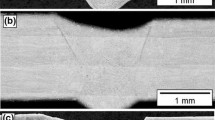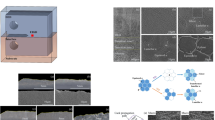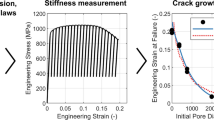Abstract
Herein, we focus on understanding the microstructure-fracture correlations in a Ti–6Al–4V alloy additively manufactured via electron beam melting (EBM) and subjected to various post-process heat-treatments. Specifically, the as fabricated material is subjected to a sub-transus heat-treatment followed by air-cooling and a super-transus heat-treatment followed by either air- or furnace-cooling. Next, a series of in-situ single edge notch tension (SENT) tests are carried out under a high-resolution digital optical microscope. The panoramic high-resolution images captured during the in-situ tests are then used to characterize the planar deformation on the specimen surface using microstructure-based digital image correlation (DIC). The results of the in-situ SENT tests together with DIC and post-mortem fractographic analyses provided us with a better understanding of the microstructure-fracture correlations in these materials. Our results show that the fracture mechanism of the as fabricated and sub-transus heat-treated materials is essentially the same, while the changes in the microstructure following the super-transus heat-treatments significantly affects the fracture mechanism. In this case, several microcracks of hundreds of microns in length first nucleate away from the deformed notch following extreme plastic deformation at discrete locations. Furthermore, the location of these microcracks in the super-transus heat-treated materials is extremely sensitive to the details of the underlying microstructure.















Similar content being viewed by others
References
Al-Bermani SS, Blackmore ML, Zhang W, Todd I (2010) The origin of microstructural diversity, texture, and mechanical properties in electron beam melted Ti-6Al-4V. Metall Mater Trans A 41:3422–3434
Antonysamy AA, Meyer J, Prangnell PB (2013) Effect of build geometry on the β-grain structure and texture in additive manufacture of Ti6Al4V by selective electron beam melting. Mater Charact 84:153–168
ASTM:E112-13 (2013) Standard test methods for determining average grain size. ASTM International, West Conshohocken
Blaber J, Adair B, Antoniou A (2015) Ncorr: open-source 2D digital image correlation matlab software. Exp Mech 55:1105–1122
Book TA, Sangid MD (2016) Strain localization in Ti-6Al-4V Widmanstätten microstructures produced by additive manufacturing. Mater Charact 122:104–112
BS:8571 (2018) Method of test for determination of fracture toughness in metallic materials using Single Edge Notched Tension (SENT) specimens. British Standards Institution, London
Cunningham R, Nicolas A, Madsen J, Fodran E, Anagnostou E, Sangid MD, Rollett AD (2017) Analyzing the effects of powder and post-processing on porosity and properties of electron beam melted Ti-6Al-4V. Mater Res Lett 5:516–525
Cvijović-Alagić I, Gubeljak N, Rakin M, Cvijović Z, Gerić K (2014) Microstructural morphology effects on fracture resistance and crack tip strain distribution in Ti–6Al–4V alloy for orthopedic implants. Mater Des 53:870–880
Dang N, Liu L, Adrien J, Cazottes S, Xiao W, Ma C, Zhou L, Maire E (2019) Crack nucleation and growth in α/β titanium alloy with lamellar microstructure under uniaxial tension: 3D X-ray tomography analysis. Mater Sci Eng A 747:154–160
de Formanoir C, Michotte S, Rigo O, Germain L, Godet S (2016) Electron beam melted Ti–6Al–4V: microstructure, texture and mechanical behavior of the as-built and heat-treated material. Mater Sci Eng A 652:105–119
Draelos L, Nandwana P, Srivastava A (2020) Implications of post-processing induced microstructural changes on the deformation and fracture response of additively manufactured Ti–6Al–4V. Mater Sci Eng A 795:139986
Facchini L, Magalini E, Robotti P, Molinari A (2009) Microstructure and mechanical properties of Ti-6Al-4V produced by electron beam melting of pre-alloyed powders. Rapid Prototyp J 15:171–178
Frazier WE (2014) Metal additive manufacturing: a review. J Mater Eng Perform 23:1917–1928
Galarraga H, Lados DA, Dehoff RR, Kirka MM, Nandwana P (2016) Effects of the microstructure and porosity on properties of Ti-6Al-4V ELI alloy fabricated by electron beam melting (EBM). Addit Manuf 10:47–57
Galarraga H, Warren RJ, Lados DA, Dehoff RR, Kirka MM, Nandwana P (2017) Effects of heat treatments on microstructure and properties of Ti-6Al-4V ELI alloy fabricated by electron beam melting (EBM). Mater Sci Eng A 685:417–428
Gross AJ, Ravi-Chandar K (2017) On the deformation and failure of Al 6061–T6 in plane strain tension evaluated through in situ microscopy. Int J Fract 208:27–52
Han Q, Kang Y, Hodgson PD, Stanford N (2013) Quantitative measurement of strain partitioning and slip systems in a dual-phase steel. Scripta Mater 69:13–16
Herzog D, Seyda V, Wycisk E, Emmelmann C (2016) Additive manufacturing of metals. Acta Mater 117:371–392
Jha JS, Toppo SP, Singh R, Tewari A, Mishra SK (2021) Deformation behavior of Ti-6Al-4V microstructures under uniaxial loading: equiaxed vs transformed-β microstructures. Mater Charact 171:110780
Kang J, Ososkov Y, Embury JD, Wilkinson DS (2007) Digital image correlation studies for microscopic strain distribution and damage in dual phase steels. Scripta Mater 56:999–1002
Kok Y, Tan XP, Wang P, Nai MLS, Loh NH, Liu E, Tor SB (2018) Anisotropy and heterogeneity of microstructure and mechanical properties in metal additive manufacturing: a critical review. Mater Des 139:565–586
Liu S, Shin YC (2019) Additive manufacturing of Ti6Al4V alloy: a review. Mater Des 164:107552
Liu Z, Zhao Z, Liu J, Wang Q, Guo Z, Zeng Y, Yang G, Gong S (2021) Effects of the crystallographic and spatial orientation of α lamellae on the anisotropic in-situ tensile behaviors of additive manufactured Ti–6Al–4V. J Alloy Compd 850:156886
Lutjering G, Williams JC (2007) Titanium. Springer, New York
Marteau J, Haddadi H, Bouvier S (2013) Investigation of strain heterogeneities between grains in ferritic and ferritic-martensitic steels. Exp Mech 53:427–439
Murr LE, Quinones SA, Gaytan SM, Lopez MI, Rodela A, Martinez EY, Hernandez DH, Martinez E, Medina F, Wicker RB (2009) Microstructure and mechanical behavior of Ti–6Al–4V produced by rapid-layer manufacturing, for biomedical applications. J Mech Behav Biomed Mater 2:20–32
Murr LE, Gaytan SM, Ramirez DA, Martinez E, Hernandez J, Amato KN, Shindo PW, Medina FR, Wicker RB (2012) Metal fabrication by additive manufacturing using laser and electron beam melting technologies. J Mater Sci Technol 28:1–14
Nandwana P, Lee Y, Ranger C, Rollett AD, Dehoff RR, Babu SS (2019) Post-processing to modify the α phase micro-texture and β phase grain morphology in Ti-6Al-4V fabricated by powder bed electron beam melting. Metall Mater Trans A 50:3429–3439
Ososkov Y, Wilkinson DS, Jain M, Simpson T (2007) In-situ measurement of local strain partitioning in a commercial dual-phase steel. Int J Mater Res 98:664–673
Raisson G, Samarov V, Sponsor Org. (1996) HIP of complex shape parts keys to development and industrial manufacturing. 1996-12-31 1996 United States. Research Org.:: ASM International, Materials Park
Ren YM, Lin X, Fu X, Tan H, Chen J, Huang WD (2017) Microstructure and deformation behavior of Ti-6Al-4V alloy by high-power laser solid forming. Acta Mater 132:82–95
Tammas-Williams S, Zhao H, Léonard F, Derguti F, Todd I, Prangnell PB (2015) XCT analysis of the influence of melt strategies on defect population in Ti–6Al–4V components manufactured by Selective Electron Beam Melting. Mater Charact 102:47–61
Tasan CC, Hoefnagels JPM, Diehl M, Yan D, Roters F, Raabe D (2014) Strain localization and damage in dual phase steels investigated by coupled in-situ deformation experiments and crystal plasticity simulations. Int J Plast 63:198–210
Zhai Y, Galarraga H, Lados DA (2015) Microstructure evolution, tensile properties, and fatigue damage mechanisms in Ti-6Al-4V alloys fabricated by two additive manufacturing techniques. Procedia Eng 114:658–666
Zhao X, Li S, Zhang M, Liu Y, Sercombe TB, Wang S, Hao Y, Yang R, Murr LE (2016) Comparison of the microstructures and mechanical properties of Ti–6Al–4V fabricated by selective laser melting and electron beam melting. Mater Des 95:21–31
Zheng X, Ghassemi-Armaki H, Srivastava A (2020) Structural and microstructural influence on deformation and fracture of dual-phase steels. Mater Sci Eng A 774:138924
Acknowledgements
The financial support provided by the Haythornthwaite Foundation through the ASME/AMD – Haythornthwaite Research Initiation Grant and the U.S. National Science Foundation grant CMMI-1944496 are gratefully acknowledged.
Author information
Authors and Affiliations
Contributions
LD-H: Methodology, Validation, Investigation, Visualization, Formal analysis, Data curation, Writing—original draft. PN: Conceptualization, Resources, Validation, Writing—review & editing. AS: Conceptualization, Methodology, Validation, Formal analysis, Data curation, Supervision, Funding acquisition, Writing—review & editing.
Corresponding author
Ethics declarations
Competing interests
The authors declare no competing interests.
Additional information
Publisher's Note
Springer Nature remains neutral with regard to jurisdictional claims in published maps and institutional affiliations.
Rights and permissions
Springer Nature or its licensor (e.g. a society or other partner) holds exclusive rights to this article under a publishing agreement with the author(s) or other rightsholder(s); author self-archiving of the accepted manuscript version of this article is solely governed by the terms of such publishing agreement and applicable law.
About this article
Cite this article
Draelos-Hagerty, L., Nandwana, P. & Srivastava, A. Microscale drivers and mechanisms of fracture in post-processed additively manufactured Ti–6Al–4V. Int J Fract 242, 207–225 (2023). https://doi.org/10.1007/s10704-023-00716-9
Received:
Accepted:
Published:
Issue Date:
DOI: https://doi.org/10.1007/s10704-023-00716-9




